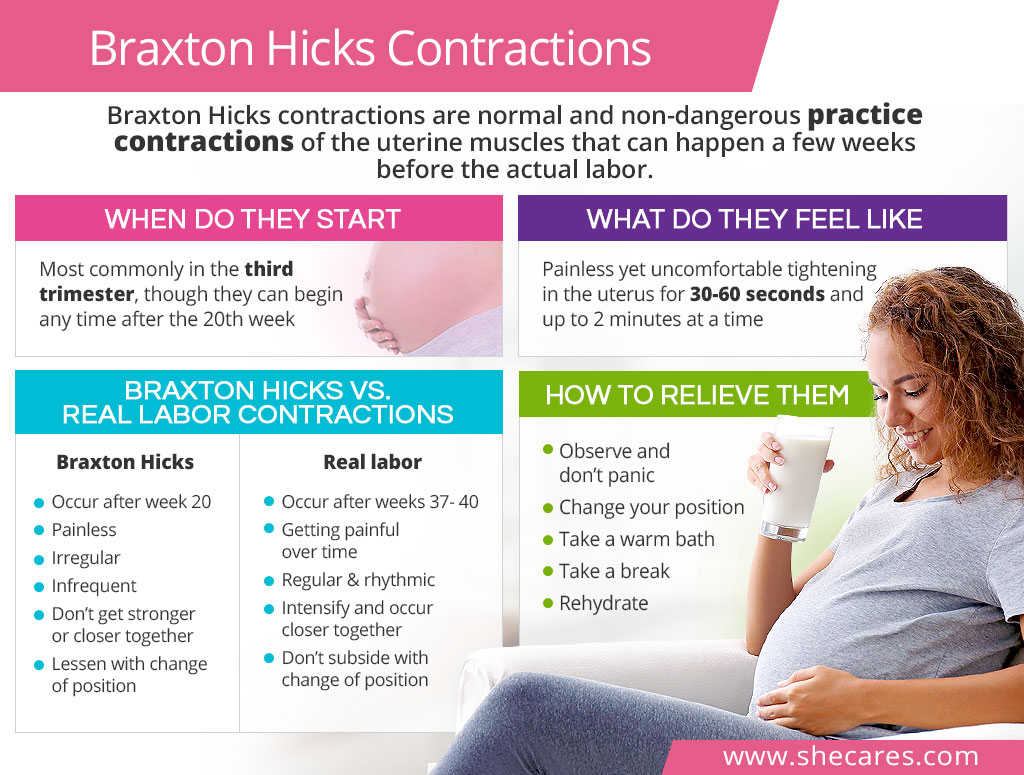What are Braxton Hicks Contractions?
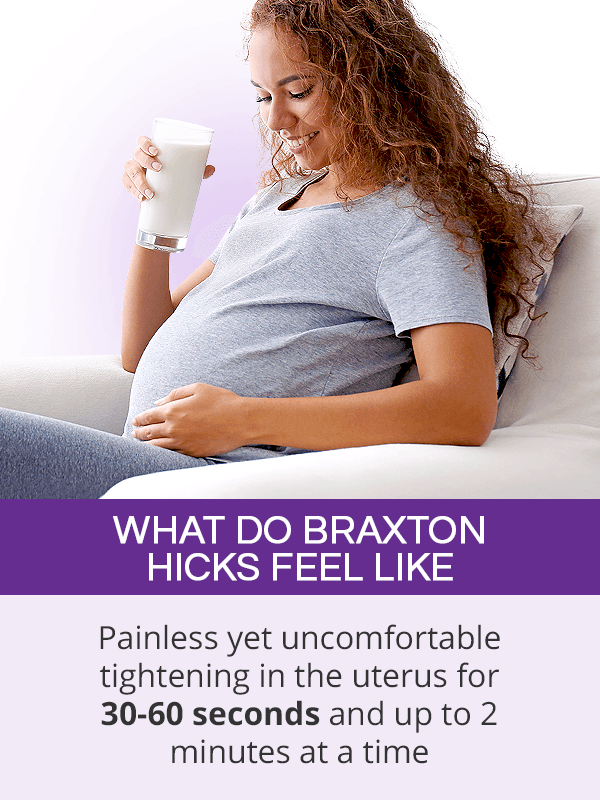
Braxton Hicks contractions are sporadic contractions of the uterine muscles in the weeks leading up to childbirth. Because they are considered a warm-up before an actual labor and do not lead to birth, they are also referred to as practice contractions or false contractions.
What do Braxton Hicks Feel Like?
Women generally report that Braxton Hicks contractions feel like a painless yet uncomfortable tightening in the lower abdomen that lasts between 30-60 seconds and up to 2 minutes at a time.1
There are no other associated Braxton Hicks symptoms.
When do Braxton Hicks Contractions Start?
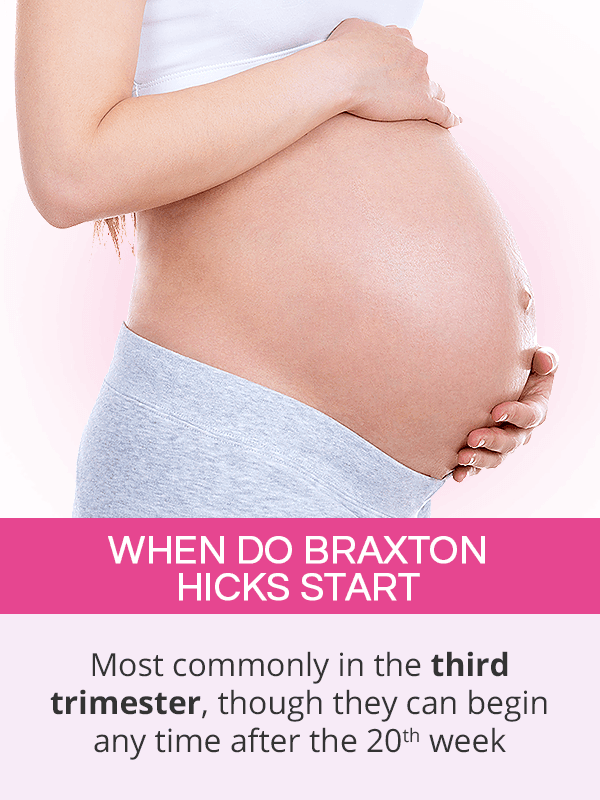
It is normal for Braxton Hicks contractions to start occasionally happening during the second trimester, after the 20th week of pregnancy.
However, most commonly, women report them during the third trimester (weeks 27-40) with an increasing frequency after the 32nd week as they approach childbirth.
What Causes Braxton Hicks Contractions?
It is unclear what exactly causes Braxton Hicks contractions. The most probable explanation is that they are designed to help build the muscles of the uterus and increase blood flow to the placenta to facilitate the upcoming childbirth.
It has been noticed that a variety of factors can trigger Braxton Hicks contractions, such as increased mother's or baby's activity, being dehydrated, having a full bladder, or having intercourse.
What’s the Difference Between Braxton Hicks and Real Contractions?
When approached with calmness and clarity of mind, the difference between Braxton Hicks contractions and real contractions is quite clear. Keeping the following in mind can help tell them apart so women can take adequate action, if necessary:
Characteristics
Braxton Hicks Contractions
Real Labor Contractions
- After the 20th week of pregnancy
- Most common in the third trimester
- Normally between the 37th and 40th weeks of pregnancy
- Irregular, without a clear pattern
- Infrequent
- Time between intervals vary
- Regular
- Grow longer, stronger, and closer together as time passes
- 30-60 seconds and up to 2 minutes
- Each varies in duration
- Start at 30 seconds and progress to 70 seconds
- Painless yet uncomfortable
- Intensity does not increase
- Subside with change of position
- Strong cramping, which gets progressively more painful with time
- Do not subside with change of position
- Usually in lower abdomen & groin
- Start at the back and move to the front
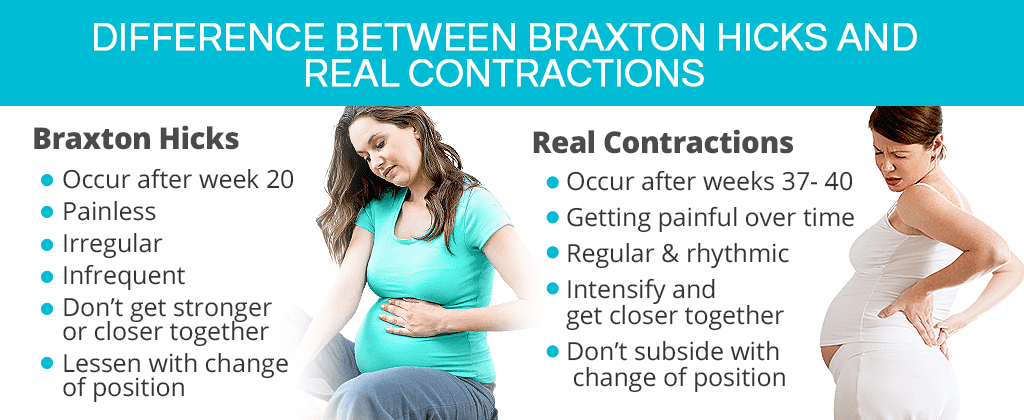
How to Relieve Braxton Hicks Contractions
The most important tip for how to relieve Braxton Hicks contractions is not to panic and observe the episode, taking note of its nature, such as duration, intensity, etc.
Although it is important to remember that they are a normal occurrence, and there is nothing that can prevent them, the following are simple ways to ease practice contractions:
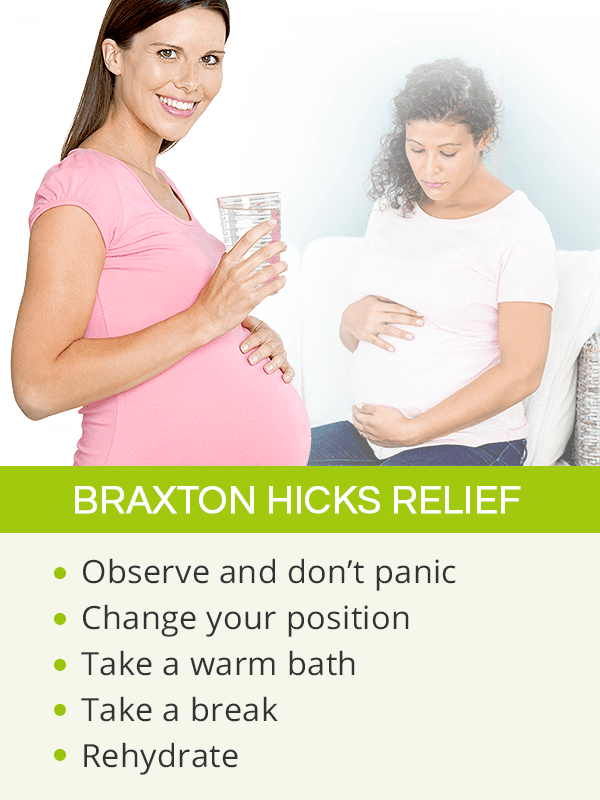
- Changing position, especially after being in one position for an extended period of time.
- Taking a warm bath or going for a massage
- Remembering to take small breaks often, especially during a busy day
- Rehydrating
When to Go to the Hospital
If a woman notices the aforementioned characteristics of real labor contractions, such as more than six rhythmic episodes of uterine cramping in an hour, she is most likely in labor and should go to the hospital.
It is important to note that contractions with these characteristics that occur before the 37th week should not be dismissed as practice contractions as they can be a sign of premature birth. Whenever in doubt, it is always best to consult with one's doctor.
Key Takeaways
Experiencing Braxton Hicks contractions, especially near real labor, is not the most comforting sensation for most mothers-to-be. However, although uncomfortable and scary, these practice contractions are how the body gets ready for childbirth. While they are normal to happen after the 20th week of pregnancy, most women report having them in the third trimester. Braxton Hicks contractions feel like a tightening in the lower abdomen that is generally painless, though uncomfortable. While they do share some characteristics with real labor contractions, there are some specific features that set the two apart, including their timing, rhythm, duration, or intensity. Whenever in doubt, it is always best to be on the safe side and double-check with one's doctor to ensure that real labor has not started.
Sources
- American Pregnancy Association. (2015). Braxton Hicks Contractions. Retrieved June 19, 2019 from https://americanpregnancy.org/labor-and-birth/false-labor/
- Better Health Channel. (n.d.). Pregnancy - premature labour. Retrieved June 19, 2019 from https://www.betterhealth.vic.gov.au/health/healthyliving/pregnancy-premature-labour
- Medline Plus. (2018). Am I in labor? Retrieved June 19, 2019 from https://medlineplus.gov/ency/patientinstructions/000508.htm
- Pregnancy, Birth & Baby. (2018). Braxton Hicks Contractions. Retrieved June 19, 2019 from https://www.pregnancybirthbaby.org.au/braxton-hicks-contractions
- StatPearls. (2019). Braxton Hicks Contractions. Retrieved June 19, 2019 from https://www.ncbi.nlm.nih.gov/books/NBK470546/
- Mayo Clinic. Guide to a Healthy Pregnancy. Da Capo Press. 2011, Boston
Footnotes:
- American Pregnancy Association. (n.d.). Braxton Hicks Contractions. Retrieved September 15, 2022 from https://americanpregnancy.org/labor-and-birth/braxton-hicks/
